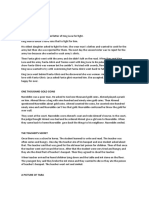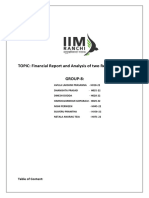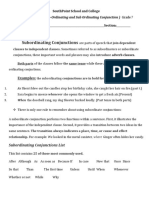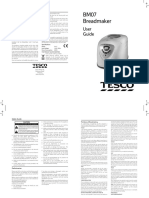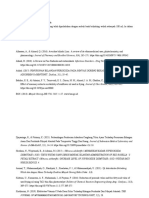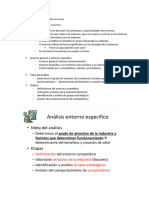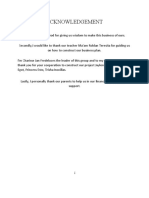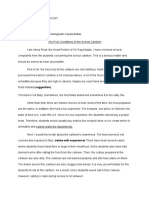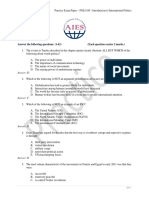Unit-2 Sector Specific Occupational Health and Safety Issues
Unit-2 Sector Specific Occupational Health and Safety Issues
Uploaded by
Jagadish KCopyright:
Available Formats
Unit-2 Sector Specific Occupational Health and Safety Issues
Unit-2 Sector Specific Occupational Health and Safety Issues
Uploaded by
Jagadish KOriginal Title
Copyright
Available Formats
Share this document
Did you find this document useful?
Is this content inappropriate?
Copyright:
Available Formats
Unit-2 Sector Specific Occupational Health and Safety Issues
Unit-2 Sector Specific Occupational Health and Safety Issues
Uploaded by
Jagadish KCopyright:
Available Formats
Unit-2
Sector Specific Occupational
Health and Safety Issues
Units of Certificate in Occupational Health and Safety
Unit 1: Introduction to Occupational Health and Safety
Definition and Context of OHS
Objectives and Principles of OHS
Workplace and Health
Occupational Health, Hygiene and Ergonomics
Unit 2: Sector Specific Occupational Health and Safety Issues
Health and Safety Risks in Mining
Health Hazards in Electronic Industry
Health Hazards in Food Processing Industry
Health Hazards in Other Industries
Unit 3: Socio-Economic Aspects of Occupational Health and Safety
Women‟s occupational and health safety
Child labour issues in occupational health and safety
Health issues in the unorganised sector
Unit 4: Basics of Preventive Techniques
What is an Accident?
Accident Analysis
Monitoring of Hazards
Reporting and Investigation of Accidents
Unit 5: Health Screening Measures
Stages of medical examination
Occupational history
Pulmonary Function Test (PFT)
Noise Induced Hearing Loss (NIHL)
Unit 6: Legal Provisions on Occupational Health And Safety
Overview of existing OHS Legislations in India
The Factories Act
The Mines Act
The Workmen‟s Compensation Act
The Employee‟s State Insurance Act
Unit 7: Participatory Research and Occupational Health
Philosophy of Participatory Research (PR)
Analysis based on PR Methodologies
Conducting Participatory Research for OHS
Certificate in Occupational Health and Safety Page 1
Unit Contents
Unit 2: Sector Specific Occupational Health & Safety Issues
Contents Page No.
2.1 Introduction 4
2.2 Learning Objectives 4
2.3 Health and Safety Risks in Mining 4
2.3.1 Environmental Hazards 5
2.3.2 Work Specific Hazards 7
2.4 Health Hazard in Electronic Industry 9
2.4.1 Debunking the Myth of a Clean Industry 9
2.4.2 Health Hazards 10
2.5 Health Hazards in Food Processing Industry 13
2.6 Health Hazards in Other Industries 18
2.6.1 The Textile Industry 18
2.6.2 The Construction Industry 22
2.6.3 The Pharmaceutical Industry 28
2.6.4 The Steel Industry 30
2.7 Glossary 33
2.8 Summary 37
2.9 Recommended for Further Reading 37
2.10 References 38
Unit-2/ Sector Specific Occupational Health and Safety Issues Page 2
2.1 Introduction
The most common illnesses in the workplace are cancers from exposure to hazardous substances,
musculoskeletal diseases, respiratory diseases, hearing loss, circulatory diseases and
communicable diseases caused by exposure to pathogens. The variety of the occupations is so
vast that not even experienced specialists, safety engineers, industrial hygienists, industrial
physicians, consultants and researchers are familiar with all the hazards that exist in each specific
occupation. The present Unit elaborates various occupational hazards of some of the occupations
like mining, textile industry, food processing, agriculture etc.
2.2 Learning Objectives
After completing this Unit, you should be familiar with the following concepts and issues.
Health hazards of the mining industry
Occupational hazards related to the electronics industry
Health hazards of the food processing industry
Health hazards of the textile industry
2.3 Health and Safety Risks in Mining
Mining is the extraction of valuable minerals or other geological materials from the earth,
usually from an ore body, vein or seam. Mining in a wider sense can also include the extraction
of petroleum and natural gas.
Mining remains one of the most difficult, dirty and hazardous occupations; causing more
fatalities than most other occupations. Although only accounting for 0.4 per cent of the global
workforce, mining is responsible for over three per cent of fatal accidents at work (about 11,000
per year, about 30 each day) throughout the world.
Workers in mines are among those who have paid and who continue to pay a high price for
inappropriate and insufficient occupational safety, health and hygiene measures. While it is true
that there has been remarkable progress in occupational safety and health, much remains to be
done. The risks to mine workers can be generalised as follows:
Environmental hazards - underground difficulties due to darkness, heat, dampness,
cramped conditions, radiation, exposure to gases such as methane, and atmospheric pressure.
Work specific hazards - explosives, physical work, noise, vibration; dust, etc.
Poisoning - due to fumes from explosives, diesel engines, resins, PVC conveyor belts, glues
and non-flammable liquids based on polychlorinated biphenyls, phosphate and glycol esters.
Biological risks - in mines with wooden pit-props or those where draught animals are used.
Unit-2/ Sector Specific Occupational Health and Safety Issues Page 4
The unpredictable and constantly changing nature of the work environment are two special
features that distinguish mining from other industrial activities. A central problem in mining and
quarrying work is the continuous movement, which necessitates special requirements for
occupational protection compared to permanent places of employment.
2.3.1 Environmental Hazards
Heat and Humidity
The environment in underground mines is generally hot and humid because of strata temperature,
heat generated by machines, heat given off by human beings and heat produced by the oxidation
of carbonaceous matter, etc. Moreover, in underground mines, the principal source of heat is
from the rock itself. The temperature of the rock goes up about 1 C for every 100 m in depth.
With the extension of mining operations going deeper and the deployment of an increasing
number of machines, health problems are acquiring greater magnitude, resulting in more
accidents and loss of efficiency.
Illumination
Poor illumination can cause stress on the visual system resulting in fatigue, which in turn leads to
production losses, inferior quality of work, increased mistakes in work, increased accident
frequency, and an eye disease known as nystagmus. Prescribed illumination levels range from
0.2 lux to 50 lux depending upon the vulnerability of locations/ operations.
Dust and fibres
Due to the nature of the work, dust has been one of the main problems in mining. The extraction
and transport of coal in mining operations can generate significant amounts of airborne
respirable coal dust. Inhalation of this dust can lead to coal workers‟ pneumoconiosis, a disabling
and potentially fatal lung disease.
In the mining of other commodities (metal, non-metal, stone, sand and gravel) and for select
occupations in coal mines, the generation of respirable silica dust is a primary concern.
Inhalation of excessive levels of silica dust can lead to silicosis, another disabling and potentially
fatal lung disease. Exposure to silica is also associated with an increased risk of tuberculosis and
some autoimmune diseases, including scleroderma.
Certificate in Occupational Health and Safety Page 5
Note Bank:
SILICOSIS
One of the oldest occupational health diseases, silicosis, is an incurable lung disease caused by the
inhalation of dust containing free crystalline silica. Silicosis affects people or workers when they
breathe in tiny silica particles released into the air with the dust created by cutting, grinding, drilling or
blasting rocks. These particles, which are less than five thousandths of a millimeter, are so small that
they can only be seen under a microscope and they remain airborne for a long time. These particles
reach the lung‟s small air sacs and damage the lung tissue. The worst of all is that over a period of time
workers exposed to silica dust are at a high risk of getting lung cancer.
Exposure to silica containing dusts occurs while working on highway construction, loading, dumping,
hauling or crushing rock, cutting or grinding or chipping stone, demolition of concrete or masonry
structures. Some of the other high risk areas are is working in mines, quarries, foundries, construction
sites, manufacturing of glass, abrasive powders, and in masonry workshops. Sandblasting is also one
of the highest risk areas. Silicosis develops after long exposure to relatively low concentrations of
silica dust. One of the most adverse impacts of silicosis is that once the disease has begun, the disease
will continue to progress even after the worker has been removed from further exposure.
Thousands of people were exposed to silica and silica related respiratory problems during the eruption
of Mount Helens in 1980s, due to the inhalation of tridymite or cristobalite in the dust that followed
the explosions. When the twin towers or the World Trade Center collapsed in New York, a lot of
people were exposed to air borne silica.
The International Agency for Research on Cancer (IARC), in 1996, has classified crystalline silica dust
as a Group 1 human lung carcinogen. Like most other dusts, initial exposure to silica causes irritation
of the eyes, nose and throat; but excessive intake into the lungs causes damage to the lung tissue. In the
initial period it leads to breathlessness during exercise, it does not show enough symptoms in the initial
10 to 20 years. It is after that its impact becomes obvious. The disease also continues to spread even
after the exposure to the source of silicosis has stopped. This is all the more dangerous and a cause for
grave concern.
Statistics from around the World
China: Lung diseases are the most frequent occupational diseases in China. Between 1991 and 1995,
China recorded more than 500,000 cases of silicosis, with around 6000 new cases and more than
24000 deaths occurring each year, mostly among older workers.
India: A prevalence of 55% was found in one group of workers – many of them very young – engaged
in quarrying shale sedimentary rock and subsequent working in small, poorly ventilated sheds.
Brazil: In Brazil, in the State of Minas Gerais alone, more than 4500 workers have been diagnosed
with silicosis. The State of Rio De Janerio banned sandblasting after a quarter of the shipyard workers
were found to have silicosis.
Latin America: Silicosis affected 37% of the miners. The Colombian Government estimates that over
1.8 million workers in the country are at risk of developing the disease.
(Luton 2007; 32-35)
Unit-2/ Sector Specific Occupational Health and Safety Issues Page 6
2.3.2 Work Specific Hazards
Noise and vibration
The noise level in mining areas is normally between 80 - 110 dB (A), but most frequently it is
between 90- 95 dB. The majority of noise comes from machines like loading, drilling and
personnel transport machines.
No permissible noise levels have been laid down in the statute for Indian mines. However based
on the ILO Code of Practice, permissible limits have been recommended by DGMS through a
technical circular. The recommended noise standards are:
Warning (Action) level- 85 dB
Danger limit for unprotected ears – 90 dB
Entry only with ear protection –115 dB
Entry to be prohibited - 140 dB
The drilling jumbos and loading machines cause vibrations in the entire body, while hand-held
drilling machines cause hand vibrations. The spectra of whole body vibrations usually have three
different peaks between 1.6 to 2.5 Hz, 6.3 to 12.5 Hz and 20 to 30 Hz. From the point of health
risk the most important frequencies are 2-4 Hz and reducing these frequencies is very difficult.
Contact with electric current
Electrical accidents are the fourth leading cause of death in mining and are disproportionately
fatal compared with most other types of mining accidents. Fatalities are caused by burns and
electrical shock. Half of all mine electrical injuries and fatalities occur during electrical
maintenance work; with the following electrical components most commonly involved are
circuit breakers, conductors, batteries, and meters. The wide variety of electrical injuries on-the-
job suggests that no single intervention strategy can eliminate occupational electrical fatalities
and injuries. Instead, multi-faceted research approaches that consider not only engineering
controls but also organisation of work, training, and personal protective equipment are needed to
mitigate electrical hazards.
Explosions
While a lot of progress has been made in preventing explosions in mines, explosions still occur,
often producing multiple fatalities. Explosions and the resulting fires often kill or trap workers,
block avenues of escape, and rapidly generate asphyxiating gases, threatening every worker
underground. Explosions can be prevented by minimising methane concentrations through
methane drainage and ventilation, by adding sufficient rock dust to make the coal dust inert, and
by eliminating ignition sources.
Certificate in Occupational Health and Safety Page 7
Fires
Fires are a significant hazard to the safety and health of mine workers. A fire in an underground
coal mine is especially hazardous due to the unlimited fuel supply and the presence of flammable
methane gas. The leading causes of mine fires include flame cutting and welding operations,
friction, electrical short circuits, mobile equipment malfunctions, and spontaneous combustion.
Several recent large coal-mine fires have resulted in mine evacuations and the temporary sealing
of the mines.
Diesel exhaust
Diesel exhaust is a potential human carcinogen, based on a combination of chemical,
genotoxicity and carcinogenicity data. In addition, over exposure to diesel exhausts has been
linked to health problems such as eye and nose irritation, headaches, nausea, and asthma.
Currently, underground miners are exposed to over 100 times the typical environmental
concentration of diesel exhaust and over 10 times that measured in other workplaces.
Inundations
TRY THIS OUT!
Inundations have also taken a
heavy toll in mines. From 1975 Can you find out more about the following?
till date there have been four Disasters due to electric sparking in mining areas
disasters in Indian mines killing include the Jitpur incident in 1973 (48 deaths) and
414 persons. Inundations take Baragolai in 1979 (16 deaths).
The Chasnala disater.
place from surface as well as
In 1965, a major disaster occurred at the Dhori mines
underground sources of water. killing 268 mine workers due to explosions.
Radiation/Radon exposure
Workers employed in uranium, hard-rock, and phosphate mining potentially are exposed to high
concentrations of radon. Uranium miners are generally believed to have the highest exposures.
Radon is formed from the radioactive decay of radium and uranium. Miners constantly exposed
to large quantities of radon have a high risk of developing lung cancer. The incidence of lung
cancer is enhanced when radon acts in combination with silica dust, diesel fumes, and typically,
cigarette smoke. Iron ore, potash, tin, fluorspar, gold, zinc, and lead mines also have significant
levels of radon.
Roof/ Rock falls
THINK TANK
Rock falls account for a large „Mining is one of the most difficult, dirty and hazardous
proportion of accidents and, in occupations.‟ Would you agree? Why?
recent times, have been caused Briefly outline the health and safety risks associated with
the mining industry.
by seismic events. These can be
The city of Dhanbad is on the verge of a disaster due to
attributed to what is generally underground fires/ land subsidence. Reflect.
termed pillar mining, where
support structures are created for
Unit-2/ Sector Specific Occupational Health and Safety Issues Page 8
the earth wall in the process of mining. Unfortunately, due to a continued process of digging
further in the attempt to reach the ore, high stress levels are caused and the pillars come under
enormous pressure, thereby leading to rock falls and seismicity.
2.4 Health Hazards in the Electronics Industry
More than any other single product, the semiconductor „chip‟ symbolises the extraordinary
progress in the industry. However, the image of the electronics industry being a clean and trim
industry – workers in spanking white gowns and caps, and stylish pants with no smoke-belching
stacks – is very misleading. Compared to other industries, electronics manufacturing has an
exceptionally high rate of illness among its workforce and has been responsible for devastating
cases of environmental pollution.
2.4.1 Debunking the Myth of a Clean Industry
Interestingly enough, the electronics industry can also be considered a chemical industry.
Electronics production utilises several thousand kinds of toxic substances. Is it not amazing to
know that Hewlett-Packard keeps Material Safety Data Sheets on over 3,000 different chemicals
at its California headquarters!!! Raw materials for electronics and electrical manufacturing are
provided almost exclusively by the chemical industry, which in turn relies heavily on mining and
the processing of basic metals and minerals such as oil and coal.
The high rate of work-related illness in electronics is still being examined. Evidence of health
hazards in electronics has only just begun to emerge, since relatively little is known about
chemical toxicology, and because it takes months or years before an illness manifests itself from
the time of the first exposure. For example, it may take anywhere from 2 to 50 years after
exposure to a carcinogen before cancer appears, and one to five years of using a microscope
daily before permanent eye damage occurs. Chemicals can leak slowly into the air, soil and
water, leading to a host of delayed health problems in nearby communities.
Certificate in Occupational Health and Safety Page 9
Health hazards common in the electronic industry
Hazardous Job/Condition Immediate Effects Long Term Effects
Sources
Acids Electroplating, etching, Skin burns, eye irritation Lung disease, bone
crystal polishing damage, erosion of teeth
Metals Electroplating, etching, Breathing problems, skin Cancer, liver damage,
soldering, tinning, sealing irritation, headaches, sterilisation, dermatitis
insomnia, stomach pain,
miscarriage
Gases Doping, crystal growing, Dizziness, nausea, Anaemia, jaundice, liver
cap testing vomiting, diarrhoea, coma damage
and death
Resins Cutting, grinding, Breathing problems, skin Cancer, liver damage,
(Plastics, encapsulation, laminating, irritation allergies, asthma
Epoxies, packaging
Glues, Flux)
Solvents Nearly every job and Skin irritation, cough, Liver damage, kidney
process; used as cleaning, breathing problems, sore damage, heart damage,
degreasing, and thinning throat, dizziness, headache, paralysis, cancer,
agents nausea allergies, menstrual
disorders
Radiation x-ray equipment, electron Redness of skin Cancer, sterility
(Non- beam equipment, high
ionizing) voltage power supplies
(unshielded)
Microscope Chip assembly, testing, Eye problems, headaches, Eye damage,
s and TV other jobs backaches tenosynovitis
monitors
Stressful Work quotas, rotating Weakness, proneness to Menstrual disorders,
work shifts, repetitive work, injury and illness pregnancy problems,
conditions many others tension, recurring illness,
general poor health
Source: Adapted from Health Hazards in Electronics-A Handbook by Thomas Gassert, Asia
Monitor Resource Centre (1985)
2.4.2 Health Hazards
The different types of health hazards are discussed below.
Chemical hazards
The electronics industry developed the clean room where dust levels are kept very low because
the smallest bit of dust can ruin the manufacture of an expensive semiconductor. To save energy
costs and to lower dust levels to near zero, filtered air is re-circulated in the clean rooms. As a
result, workers are repeatedly and continually exposed to re-circulated mixtures of chemicals
because the fumes and vapours of many hundreds of chemicals cannot be completely removed
by air and particulate filters.
Unit-2/ Sector Specific Occupational Health and Safety Issues Page 10
In the electronics manufacturing industry, workers are exposed to chemicals mainly by contact
and inhalation. All communities are also exposed to a variety of chemicals when electronics
factories release toxic waste into the local air, water and soil. The hazardous chemicals can have
both acute (quick reaction usually after exposure to a large amount of a chemical) and chronic
(delayed reaction, often worsening gradually over time) effects. The effects can also be classified
as local effects (effect develops at the place of contact) and systemic effects (effect develops at
places in the body other than where the chemical has made contact with the body).
Irritation and allergic reactions are some of the more common health problems experienced by
workers exposed to chemicals in electronics manufacturing. Some of the common allergens and
irritants include organic solvents, solder flux, aldehydes, epoxy resins, curing agents, metal dusts
and fumes, acrylates, isocynates, inorganic acids, plastic resins and additives, waxes, aniline
dyes, alkali detergents, etc.
Some of the common allergic reactions prevalent in the electronics industry are conjunctivitis,
sinusitis, chronic bronchitis, asthma, alveolitis, dermatitis, and pruritis.
The ability of workers in the electronics industry to have a normal sex life and to give birth to
healthy children is threatened by three job hazards – chemicals, radiation and stress. The sex life
of both male and female workers can be affected. Some of the effects are change in sexual
behaviour, problems in the reproductive system, abnormal pregnancy, birth defects and
accumulation of mutated genes in future generations.
The cancer risk for workers in the electronics industry may be higher than for the general
population in urban industrial areas. At least 20 per cent (and perhaps up to 50 %) of electronics
and electrical workers or at least one out of every five workers face the risk of cancer-causing
substances on the job. The groups of chemicals that cause higher rates of cancer risk include
petroleum and fuel oils, heavy metals and their compounds, chlorinated hydrocarbons and other
solvents, vinyl chloride, acrylonitrile, ethylene oxide and other plastic resins, and asbestos.
Radiation hazards
Many electronic workers are exposed to radiation on the job. The most common forms of low
risk radiation in electronics are heat (radio frequency radiation) and artificial light (fluorescent
lamps). Evidence suggests that even low amounts of both ionizing (e.g. x-rays, gamma rays,
radioisotopes, neutrons) and non-ionizing radiation (e.g. radio frequency, microwaves, infrared
and ultraviolet light) can be dangerous to workers.
Most ionizing forms of radiation penetrate the skin and instantly damage or destroy the tiny cells
of the human body. The damage is almost irreversible. The amount of cell damage depends on
the dose or strength and duration of the exposure to radiation. Exposure to ionizing radiation is
more likely to occur in the wafer fabrication process, in the manufacture of PCBs (printed circuit
board) and when using radioisotopes such as krypton-85 to check for leaks after encapsulation in
the process of semiconductor assembly. Results of exposure can include cancer, genetic
mutation, aplastic anaemia, and birth defects in children, miscarriages, decreased life expectancy
and premature ageing.
Certificate in Occupational Health and Safety Page 11
Non-ionizing radiation is generally thought to be less dangerous but new evidence about the
health effects of exposure to microwaves is causing concern. Laser beams, used for cutting and
drilling, can cause instant destruction of human tissue. Non-ionizing forms of radiation usually
affect the eyes, skin and testes (male reproductive organs). Microwaves, ultraviolet light and
lasers are among the most dangerous kinds of non-ionizing radiation.
Eye hazards
One of the saddest stories to emerge so far in the brief history of electronics manufacturing is the
permanent loss of eyesight suffered by thousands of young workers solely because of unjust and
unhealthy working conditions. Eye problems like chronic conjunctivitis, near sightedness and
astigmatism are remarkable considering that, for most jobs, only applicants with 20/20 vision
(perfect eyesight) are hired. The main causes of eye problems in these workers are stress,
radiation hazards of using scopes and TV monitors, chemical vapours, fumes, dust, and gases
that cause irritation.
Eye problems can be grouped as eyestrain, eye irritation, and eye damage. Conjunctivitis, known
as „pink eye‟ (inflammation of the mucous membrane) is caused by irritant chemicals. Near
sightedness (myopia) is perhaps the most common form of eye damage resulting from repetitive
detailed work with scopes or monitors. The toxic effects of chemicals may result in the loss of
normal colour perception, loss of peripheral vision, hallucinations, decreased ability to see in the
dark, blurred vision, loss of normal eye-hand coordination, reduced vision and blindness. In
addition, eye problems can lead to other complications like headache, dizziness, fatigue,
inattention, irritability, nervousness, insomnia, hallucinations, stress, etc.
Noise Hazards
In the electronics industry, machinery such as metal stampers, cutting equipment, motors and
packaging machines may emit excessively loud noise. High frequency noise is also emitted from
ultrasound equipment used for bonding and testing components and for other purposes. The pain
threshold of noise is about 120-140 dB. Most work related hearing loss is caused by prolonged
exposure to noise over 80 dB. Signs of stress, such as increased heart rate (rapid pulse) have
been observed in people exposed to continuous noise at levels between 60 and 70 dB.
Stress
Stress is an important, but often overlooked factor in health and safety hazards at work. In
electronics manufacturing, there are three main cause of stress - ergonomic, economic and
social.
Ergonomic causes of stress are those that involve the worker‟s biological-mechanical (physical)
relationship to the job he/she must perform and the equipment he or she must use. This includes
body-task positioning (position of the work table, height of the chair and its hardness, poor
lighting, etc.), repetitive movements (leading to strain, irritation and possibly diseases of nerves,
tendons and muscles and), noise (high volume or frequency contributes to mental, physical as
Unit-2/ Sector Specific Occupational Health and Safety Issues Page 12
well as mental stress symptoms), vibration (damage to muscles and bones) and extreme
temperatures (higher rates of bronchitis, pneumonia, chances of cold, sore throat, etc).
Economic causes include inadequate wages and benefits to the workers, piece-rate or quota wage
systems (more competition among the workers), lack of job security, lack of health benefits and
the lack of decent housing and overtime, shift work and work speed-ups.
Social causes of stress include the lack of control or decision-making about one‟s job or the way
the workplace is run. The common factors are sexual, racial, class, religious and intellectual
discrimination, lack of reward or encouragement for the efforts and achievements of a worker
and poor relationship between a worker and his supervisor.
NOTE BANK
„Electronics industry is a clean industry.‟ Would you agree? Give reasons for your answer.
What is the prevalence of eye hazards in the electronics industry?
2.5 Health Hazards in the Food Processing Industry
The food processing industry covers a series of activities directed at the processing, conversion,
preparation, preservation and packaging of foodstuffs. The raw materials used are generally of
vegetable or animal origin and produced by agriculture, farming, breeding and fishing. In spite of
the extreme diversity of the food industries, the preparation processes can be divided into
handling and storage of raw materials, extraction (extract a specific food product from fruit,
cereals or liquids), processing (general procedures used are fermentation, cooking, dehydration
and distillation), preservation (prevent any deterioration of food products by processes like
radiation sterilisation, antibiotic sterilisation, chemical action, dehydration, and refrigeration),
and packaging (by processes like canning, aseptic packaging and frozen packaging).
The food processing industry is one of the world‟s largest employment sectors. While the
industry has a below-average nonfatal injury incidence rate, awareness on the health and safety
hazards involved in the sector gains significance considering the number of people engaged.
The most common causes of injuries in the food industry are hand tools, especially knives;
operating machinery; collisions with moving or stationary objects; falls or slips; and burns.
Electrical shocks can occur in electrical installations, especially in wet or damp places. Fires and
explosions may occur in gas or oil-fired ovens or cooking processes if they are not installed,
operated or maintained correctly; provided with the essential safety devices; or if proper safety
procedures are not followed (especially in open flame operations).
Respiratory Problems
Common respiratory problems related to food processing industry are rhinitis that affects the
nasal passages; broncho-constriction in the major airways; and pneumonitis, which consists of
Certificate in Occupational Health and Safety Page 13
damage to the finer structure of the lung. Exposure to airborne dust from various foodstuffs as
well as chemicals may lead to emphysema and asthma (e.g. organic dust from grain or flour can
cause “baker's asthma”). Rhinitis and chronic coughs are common among slaughterhouse and
pre-cooked foods workers. Respiratory disorders are also caused due to allergens and antigens
originating in foodstuffs, such as egg protein and seafood products.
Among the hazards due to microbiological processes involved in the food processing,
Tricoderma and Penicillium are prominent. Penicillium is found in dairy and meat processing
plants (and various other sectors); during the maturing of cheeses and sausages, there can be
abundant surface growth. Occupational asthma cases have been associated with many of these
organisms, while some are also suspected of causing infection or carrying mycotoxins. The
enzymes trypsin, chymotrypsin and protease are associated with hypersensitivity and respiratory
disease.
Inhalation of hazardous chemical substances used as reagents, refrigerants, fumigants and
sanitizers may cause respiratory and other disorders. Exposure at or above the recognised limits
often results in skin or eye irritation and respiratory disorders. Headaches, salivation, burning of
the throat, perspiration, nausea and vomiting are symptoms of intoxication due to overexposure.
Skin Disorders
The common skin problems found in the food and drink industries are dermatitis and contact
allergies (e.g., eczema). Due to sanitation requirements, workers are constantly needed to wash
their hands with soap and using hand-dip solutions that contain quaternary ammonium solutions.
This constant wetting of the hands can reduce the lipid content of the skin and lead to dermatitis.
Working with fats and oils can clog the pores of the skin and lead to acne-like symptoms. These
primary irritants account for 80 per cent of all occupational dermatitis seen. Workers may
become highly sensitised to microbial proteins and peptides generated by fermentation and
extraction, which can lead to eczema and other allergies. Occupational dermatitis is also reported
when working with enzymes, such as trypsin, chymotrypsin and protease.
Ionizing radiations sometimes used during the processing of the food or food sterilisation etc.
also pose a health hazard.
Parasitic Infection
Infectious and parasitic diseases of animal origin are the occupational diseases most specific to
the food and drink industries. The diseases are most common among meat-packing and dairy
workers as a result of direct contact with infected animals.
Noise and Hearing Related Problems
Hearing impairment occurs as a result of continuous and prolonged exposure to noise above
recognised threshold levels. There is also an association between exposure to high noise levels
and abnormal blood pressure, increased heartbeat, increased respiration rate/volume, stomach
and intestinal spasms and nervous disorders.
Unit-2/ Sector Specific Occupational Health and Safety Issues Page 14
It is estimated that more than 60 per cent of the workers in the food industry are facing health
hazards because of higher noise levels. Technological progress can be singled out as the chief
culprit; the noise hazard faced by workers has increased as a result of mechanised and semi-
automated production methods.
Musculoskeletal Disorders
Work in meat, poultry, fish and food processing plants tends to involve repetitive and
monotonous movement and that too at a gruelling pace, particularly in slaughterhouses and in the
manufacture of sausages and canned food. Most of the strain is exerted on the upper extremities.
Repetitive strain injuries (RSIs) include inflammation of the tendon (tendinitis) and
inflammation of the tendon sheath (tenosynovitis). Tasks that repeatedly combine the bending of
the wrist with a gripping, squeezing and twisting motion can cause carpal tunnel syndrome
(CTS). Characterised by a tingling sensation in the thumb and first three index fingers, CTS is
caused by inflammation in the wrist joint creating pressure on the nerves in the wrist.
Misdiagnosis of CTS as arthritis can result in permanent numbness and severe pain in the hands,
elbows and shoulders. Vibration disorders also accompany an increased level of mechanisation.
Heat and Cold Related Problems
Thermal extremes exist in the food work area. People must work in freezers with temperatures of
–180C or below. Freezer clothing helps insulate the worker from the cold, but warm break rooms
with access to warm liquids must be provided. Meat-processing plants must be kept at 7 to 10 0C.
This is below the comfort zone and workers may need to wear additional clothing layers. Heat,
often combined with high humidity in cooking and sterilising, can produce an equally intolerable
physical environment, where heat stroke and heat exhaustion are areas of concern. These
conditions are especially found in processing that entails evaporation of solutions, such as tomato
paste production, often in countries where hot conditions already prevail. It is also prevalent on
the floors of slaughterhouses. Ovens and steam cookers also emit radiant and moist heat.
Certificate in Occupational Health and Safety Page 15
Note Bank:
Status of Occupational Health and Safety in Five Star Hotels
A Case Study of Ashoka Hotel
(Harsh Jaitli & Gopal Singh, 1997, PRIA)
Ashoka Hotel is located in the heart of South Delhi within a distance of about 12 km from the airport and the
railway station. It is one of the „Ashok Group of Hotels' in India. It has been rated as a 'five star hotel'.
Administratively, it is maintained by the Indian Tourism Development Corporation (ITDC) under the guidance
of the Ministry of Tourism and Industry. A study was conducted to study and analyse and document health and
safety conditions of the workers in the hotel and also to analyse the available infrastructural facilities related to
the health and safety measures available to the workers of the 5-star hotel. The findings have been be
summarised in the following Tables.
Working Conditions of the Workers (% response)
Factors Low Medium High No Response
Temperature 23.3 61.7 10.0 5.0
Noise 5.0 45.0 23.3 26.7
Fumes 3.3 21.7 1.7 73.3
Working posture 1.7 35.0 1.7 61.7
Mental stress 11.7 60.0 8.3 20.0
Constant contact with water 23.3 41.7 20.0 15.0
Constant contact with
46.7 3.3 3.3 46.7
chemicals
Frequent changes in
20.0 35.0 18.3 26.7
temperature
Customer's rude behaviour 28.3 11.7 10.0 500
Waste disposal system 23.3 15.0 5.0 56.7
Injecting fresh air 38.3 20.0 3.3 38.3
Other irritants 5.0 13.3 8.3 73.3
Health Conditions of the Workers (% response)
Diseases Never Sometimes Regular No response
Fever 26.7 65.0 3.3 5.0
Respiratory problems 50.0 15.0 0.0 35.0
Cardiovascular problems 55.0 3.3 0.0 41.7
Skin problems 38.3 3.3 1.6 56.7
Eye problems 45.0 25.0 6.7 23.3
Mental strain 41.7 35.0 5.0 18.3
Orthopaedic problems 43.3 10.0 5.0 41.7
Digestive problems 43.3 18.3 15.0 23.3
Blood pressure problems 40.0 6.7 6.7 46.7
Other illnesses 30.0 1.7 0.0 68.3
Unit-2/ Sector Specific Occupational Health and Safety Issues Page 16
NOTE BANK
State of Safety Conditions available to Hotel Workers
Parameters Good Satisfactory Bad No response
Electrical wiring 16.7 21.7 46.7 20.0
State of equipment 13.3 23.3 40.0 23.3
On-off switch of
25.0 36.7 16.7 21.7
equipment
Protection on moving
13.3 21.7 50.0 15.0
parts
Emergency switch 36.7 30.0 16.7 16.7
Medical Facilities Availed by the Workers
Parameters Response (%)
Private doctors 18.3
Hotel doctors 26.7
ESI doctors 20.0
No response 35.0
Availability of Personal Protective Equipment (% response)
Parameters Once Rarely Never No response
Gum boots - - 61.7 38.3
Gown - - 60.0 40.0
Ear plugs - - 60.0 40.0
Mask - - 60.0 40.0
Gloves - 1.7 60.0 38.3
In conclusion, infrastructure facilities available to the workers are inadequate. Lack of proper ventilation,
arduous duty hours, extreme changes in the temperature, bad disposal system of waste coupled with
poor availability of medical facilities are responsible for health hazards faced by the workers. There is an
immediate need to provide adequate and feasible health protective measures to all the workers.
Think Tank:
What are the main causes of illness/disease in the food processing industry?
List the health hazards in the meat packing and related industries.
Certificate in Occupational Health and Safety Page 17
2.6 Health Hazards in Other Industries
2.6.1 The Textile Industry
The term textile (derived from the Latin texere, to weave) was originally applied to the weaving
of fabrics from fibres, but now it includes a broad range of other processes such as knitting,
tufting, felting and so on. It has also been extended to include the making of yarn from natural or
synthetic fibres as well as the finishing and dyeing of fabrics. Textile industries entail diverse
operations including fibre synthesis, blow room/ card room operations, weaving, spinning,
manufacturing, dyeing and finishing.
The textile manufacturing industry employs over ten million workers throughout the world. Like
any other processing industry, the workers face various health hazards. The hazards include
chemical poisoning because of exposure to solvents in the cleansing and dyeing processes, lung
and skin diseases due to exposure to dust particles and allergy to fabrics, ergonomic problems
such as back, neck and shoulder pain, joint diseases in the sewing processes, cuts, injuries and
accidents while using various machinery, long working hours and work stress and many others.
Health Hazards in Cotton Units
Cotton dust inhalation (byssinosis)
Dust is generated when cotton fibre is converted into yarn and fabric and inhalation of this dust
causes an occupational lung disease called byssinosis in about seven to eight per cent of textile
workers. It is also known as mill fever, cotton fever (brown lungs) or hemp fever. It usually takes
15 to 20 years of exposure to higher levels of dust (above 0.5 to 1.0mg/m 3) for workers to
actually start suffering from related diseases.
The dust, an airborne particulate released into the atmosphere when cotton is handled or
processed, is a heterogeneous, complex mixture of botanical trash, soil and microbiological
material (i.e., bacteria and fungi), which varies in composition and biological activity. The cotton
dust enters into the alveoli of the lungs and the continuous accumulation in the lungs reduces the
lung‟s capacity to retain oxygen and the worker develops a brown lung.
Noise
Noise is often a problem in some processes of yarn manufacturing, but in a few modern textile
mills the levels are below 90 dB, thanks to modern machinery which is quieter. Normally, the
noise levels in the textile industry range between 102-114 dB. Noise can have both auditory (like
hearing loss) and non-auditory effects (like sleep disorders, mental fatigue, and irritability and
reduced alertness).
Unit-2/ Sector Specific Occupational Health and Safety Issues Page 18
Heat stress
Since spinning sometimes requires high temperatures and artificial humidification of the air, the
entire set up can cause heat stress.
Health Hazards in Wool Units
Like other sectors of the textile industry, large machines with rapidly moving parts pose both
noise and mechanical injury hazards in wool units. The risk of accidents is increased if
insufficient space is allowed between the machines. Fire is a serious hazard, especially in old
multi-storey mills.
Anthrax
The industrial disease usually associated with woollen textiles is anthrax. Anthrax is caused by
bacteria called bacillus anthracis that can survive for long periods of time in the form of spores.
The main cause for anthrax is using wool which has not been disinfected (to kill the spores that
causes anthrax) it. Hence, at one time it posed great danger, particularly to the wool sorters. The
wool is disinfected by microwaving the wool bale for a sufficiently long period at a temperature
that will kill any spores. Besides anthrax spores, the spores of the fungus coccidioides immitis
can also be found in wool. This fungus can cause the disease known as coccidioidomycosis,
which usually has a poor prognosis like anthrax.
Chemical substances
Various chemicals are used in the wool industry for example, for degreasing (diethylene dioxide,
synthetic detergents, trichloroethylene and, in the past, carbon tetrachloride), disinfection
(formaldehyde), bleaching (sulphur dioxide, chlorine) and dyeing (potassium chlorate, anilines).
The risks include gassing, poisoning, irritation of the eyes, mucous membranes and lungs, and
skin conditions.
Noise
With all the moving parts in the machinery, particularly the looms, woollen mills are often very
noisy places. This is often due to the lack of proper lubrication of machine parts or the non-
introduction of sound baffles and other engineering solutions for reducing noise. The symptoms
are the same as in other cases.
Health Hazards in Silk Units
Carbon Monoxide
The symptoms of carbon monoxide toxicity are usually headache, vertigo and sometimes nausea
and vomiting.
Certificate in Occupational Health and Safety Page 19
Dermatitis (Mal des bassines)
Dermatitis of the hands of female workers reeling raw silk is quite common, particularly in
Japan. The skin lesions, localised mainly on the fingers, wrists and forearms, are characterised by
erythema covered with small vesicles, which become chronic, pustular or eczematous and
extremely painful. This is usually attributed to the decomposition products of the dead chrysalis
and to a parasite in the cocoon.
Respiratory tract problems
A kind of tonsillitis often occurs among silk spinners due to a bacterial infection from the silk
cocoons. Sometimes, workers in the natural silk industry may develop respiratory allergy
featuring bronchial asthma, asthmatiform bronchitis and/or allergic rhinitis.
Noise
Noise exposure can reach harmful levels for the workers at the machines spinning and winding
the silk threads, and at looms where the fabric is woven.
Health Hazards in Viscose Rayon and Synthetic Fibre Units
Viscose Rayon Units
The principal hazards in the viscose process are exposure to carbon disulphide and hydrogen
sulphide. Both have a variety of toxic effects depending on the intensity and duration of the
exposure and the organ(s) affected; they range from fatigue and giddiness, respiratory irritation
and gastrointestinal symptoms to profound neuropsychiatric disturbances, auditory and visual
disorders, deep unconsciousness and death.
Synthetic Fibre Units
Exposure to toxic and inflammable chemicals, accidents and injuries due to machine parts etc.,
slips and falls due to dirty and slippery floors and passages, and noise are some of the
occupational hazards in this industry. Mill fever is also associated with this industry.
Health Hazards in Carpet Units
Largely a cottage industry, carpet weaving is fraught with the hazards because of impoverished
homes with small, crowded rooms that have poor lighting and inadequate ventilation. The
equipment and processes are passed along from generation to generation with little or no
opportunity for the education and training that might give them a break from traditional methods.
Carpet weavers are subject to skeletal deformations, eyesight disorders and mechanical and toxic
hazards.
Skeletal deformation
Unit-2/ Sector Specific Occupational Health and Safety Issues Page 20
The squatting position that the weavers must occupy on the old type of looms, and the need for
them to lean forward and stretch to access the point where they knot the yarn, may, over time,
lead to serious skeletal problems. These are often compounded by the nutritional deficiencies
associated with poverty.
Vision disorders
The constant close focus on the point of weaving or knotting may cause considerable eyestrain,
particularly when the lighting is inadequate. It should be noted that electric lighting is not
available in many home workplaces, and the work, which is often continued into the night, must
be performed by the light of oil lamps. There have been cases of almost total blindness occurring
after long years of work.
Hand and finger disorders
The constant tying of small knots and the threading of the weft yarn through the warp threads
may result in swollen finger joints, arthritis and neuralgia causing permanent disabilities of the
fingers.
Stress
The high degree of skill and constant attention to detail over long hours are potent psychosocial
stressors, which may be compounded by exploitation and harsh discipline. Children are often
“robbed of their childhood”, while adults, who often lack the social contacts essential for
emotional balance, may develop nervous illnesses manifested by trembling of the hands (which
may hamper their work performance) and sometimes mental disorders.
Chemical hazards
The dyestuffs used, particularly those that contain potassium or sodium bichromate, may cause
skin infections or dermatitis. The use of ammonia, strong acids and alkalis also pose a risk. Lead
pigments sometimes used by designers, cause lead poisoning due to the practice of smoothing
the tip of the paintbrush between the lips.
Biological hazards
There is a danger of anthrax infection from contaminated raw wool from areas where the bacillus
is endemic.
Think Tank:
Briefly describe the health hazards in the textile industry.
What are the special problems related with carpet units?
Certificate in Occupational Health and Safety Page 21
2.6. 2 The Construction Industry
The International Labour Organisation (ILO) classifies the construction industry as government
and private sector firms erecting buildings for habitation or for commercial purposes and public
works such as roads, bridges, tunnels, dams or airports. The construction industry covers a wide
range of activities as it is not only involved in constructing bridges, roads or buildings, but also
includes the construction of dams, bridges, tunnels, canals, power plants, industrial structures,
factories, sewerage, laying of railways, tramway, pipelines, cables and ropeways, erection of
towers, chimneys etc. The construction industry also includes the demolition and maintenance of
structures and services.
Throughout the world, over 90 per cent of the construction workers are male. Although it has
been seen that the proportion of women is higher in some developing countries, they are usually
concentrated in the unskilled jobs where as in some countries the work is left to migrant workers.
For many unskilled workers, the construction industry is their entry into the paid labour force.
There is little doubt that many developing countries like India and China have seen a dramatic
increase in output and employment in the construction industry in the past 30 years. For example
in China, in the year 2002, the output of the construction industry was around US$ 100 billion.
Numerous studies have shown that construction output is growing rapidly often exceeding the
overall economic growth rate. The industry employed more than 36 million people, doubling its
share of the total workforce from 2.3 per cent to 5.2 per cent. The construction industry plays a
major role in combating the high levels of unemployment and in absorbing surplus labour from
rural areas.
In India the construction sector has been steadily growing since Independence. It is the prime
mover for the growth of the nation‟s infrastructure and produces goods and services worth Rs.2.1
trillion. The industry is also the second largest employer, as it employs 31 million persons round
the year (Source: Construction Industry Development Council, New Delhi).
Construction workers are exposed to a wide variety of health hazards on the job. As in other
jobs, the hazards faced by the can be chemical, physical, and social.
Chemical Hazards
Chemical hazards are often airborne and can appear as dust, fumes, mists, vapours or gasses,
thus, exposure usually occurs by inhalation, although some airborne hazards may settle on and be
absorbed through the skin (e.g. pesticides and some organic solvents). Chemical hazards also
occur in liquid or semi liquid state (e.g. glues or adhesives, tar) or as powders (e.g. dry cement).
Skin contact with chemicals in this state can occur in addition to the possible inhalation of the
vapour resulting in systemic poisoning or contact dermatitis. Chemicals might also be ingested
with food or water, or might also be inhaled by smoking. Hazards caused through:
- Inhalation of respirable dust and fumes, various respiratory problems occur due to the
inhalation of dust fumes like cement or sand dust, which ultimately blocks the respiratory
tract and results in an increase in the breathing rate. Similarly, the constant inhalation of
Unit-2/ Sector Specific Occupational Health and Safety Issues Page 22
solvent fumes like paints, varnish, glue, etc also affects the breathing rate and causes various
problems.
- Radiation and Light, workers involved in welding work are constantly exposed to a high
wavelength of light and the radiations caused by this, have a detrimental effect on them.
Several illnesses have been linked to the construction trade, among them are:
Silicosis among sand blasters, tunnel builders and rock drill operators
Bronchitis among welders
Skin allergies among masons and others who work with cement
Neurologic disorders among painters and others exposed to organic solvents and lead.
Elevated death rates from cancer of the lungs and the respiratory tract have been found among
insulation workers, roofers, welders and some woodworkers. Lead poisoning occurs among
bridge rehabilitation workers and painters, and heat stress (from wearing full-body protective
suits) among workers who clean hazardous waste and in roofers.
Physical Hazards
Workers in the construction industry face various types of physical hazards which have been
listed below.
- Extreme temperatures - Workers have to work in extreme hot or cold environments and
even in foggy, snowy, rainy, or windy weather and even at night. Hazards from heat and cold
are primarily caused, because a large portion of construction work is done while exposed to
the weather. Heavy equipment operators may sit beside a hot engine and in an enclosed cab
with no roof and without any protection from the sun. Workers in protective gear, such as
that needed for the removal of hazardous waste, may generate metabolic heat from hard
physical labour and get little relief since the suit is usually airtight. Construction workers also
work in especially cold conditions during the winter, with the danger of frostbite and
hypothermia and the risk of slipping on ice.
- Noise, prolonged exposure to noise that is caused by different machines leads to hearing loss.
- Radiation, radiation from the machines used to gauge the pipes; welding, etc has a
detrimental effect on the body. The principal sources of non-ionizing ultraviolet (UV)
radiation are the sun and electric arc welding.
- Vibration, the continuous use of drilling machines, etc., adversely affects either the entire
body or the parts of the body like hands or arms of the workers. The machines that have
today made construction an increasingly mechanised activity have also made it increasingly
noisy. Pneumatic hammers, various hand tools and earth moving machines and other large
mobile machines also subject workers to segmental and entire body vibrations.
- Barometric pressure - Those who work under water or in pressurised tunnels, such as divers
are exposed to high barometric pressure. Such workers are at risk of developing a variety of
conditions associated with high pressure, such as decompression sickness, inert gas narcosis,
aseptic bone necrosis and other disorders.
- Strains and sprains are among the most common injuries among construction workers.
These, and many chronically disabling musculoskeletal disorders (such as tendonitis, carpal
Certificate in Occupational Health and Safety Page 23
tunnel syndrome and low-back pain) occur as a result of traumatic injury, repetitive forceful
movements, awkward postures or overexertion. Falls due to unstable footing, unguarded
holes and off scaffoldings and ladders are very common.
Biological Hazards
Diseases and illnesses can occur from biological sources. The exposure to biological sources can
occur during demolitions, renovations, sewer repairs, etc and these biological sources are:
- Soil
- Water
- Insects and animal bites.
Psychological Hazards
The construction industry covers a large proportion of working population; hence it becomes
necessary to study their social life. There is a lot of instability in their lives, which affects their
health and psychological conditions along with their social as well as economic life as explained
below:
a) Social Life
Construction workers are normally migrants and unorganized workers and because of this they
constantly move from one place to another or from one site to another or from one state to
another, because of which they are unable to develop a normal social life or are unable to build a
relationship with their neighbours because they have to keep adjusting to new surroundings. In
India the female workforce involved in construction is quite large. They are victims of a dual
workload as well malnourishment. Most of the women workers involved in heavy jobs and are
paid less than their male counterparts.
b) Economic Life
The jobs in the industry are casual, temporary and irregular which leaves the workers feeling
insecure. The majority of the workers are employed on a contract basis through petty contractors,
hence there is no relationship between the employer and the employee, which leads to lack of
welfare facilities and the absence of social security measures.
A majority of the workers employed are poor migrants from drought prone villages. As they are
usually uneducated, landless and unemployed, they are easily absorbed in the construction
industry as unskilled workers and are given minimum wages. Construction workers lead a hand
to mouth existence.
Primary Hazards encountered in Skilled Construction Trades
Each trade is listed below with an indication of the primary hazards to which a worker in that
trade might be exposed. Exposure may occur to either supervisors or to wage earners. Hazards
that are common to nearly all construction workers i.e., heat, musculoskeletal disorders and
Unit-2/ Sector Specific Occupational Health and Safety Issues Page 24
stress have not been listed.
The classification of construction trades given here is the same as that used in the United States
and includes the construction trades as classified in the Standard Occupational Classification
system developed by the US Department of Commerce. This system classifies the trades by the
principal skills inherent in the trade.
Occupations Hazards
Brick masons Cement dermatitis, awkward postures, heavy loads
Stonemasons Cement dermatitis, awkward postures, heavy loads
Hard tile setters Vapour from bonding agents, dermatitis, awkward postures
Carpenters Wood dust, heavy loads, repetitive motion
Drywall installers Plaster dust, walking on stilts, heavy loads, awkward postures
Electricians Heavy metals in solder fumes, awkward posture, heavy loads,
asbestos dust.
Electrical power installers and Heavy metals in solder fumes, heavy loads
repairers
Painters Solvent vapours, toxic metals in pigments, paint additives
Paperhangers Vapours from glue, awkward postures
Plasterers Dermatitis, awkward postures
Plumbers Lead fumes and particles, welding fumes
Pipe fitters Lead fumes and particles, welding fumes
Steamfitters Welding fumes, asbestos dust
Carpet layers Knee trauma, awkward postures, glue and glue vapour
Soft tile installers Bonding agents
Concrete and terrazzo finishers Awkward postures
Glaziers Awkward postures
Insulation workers Asbestos, synthetic fibres, awkward postures
Paving, surfacing and tamping Asphalt emissions, gasoline and diesel engine exhaust, heat
equipment operators
Rail-and track-laying equipment Silica dust, heat
operators
Roofers Roofing tar, heat, working at heights
Sheet metal duct installers Awkward postures, heavy loads, noise
Structural metal installers Awkward postures, heavy loads, working at heights
Welders Welding emissions
Solderers Metal fumes, lead, cadmium
Drillers, earth, rock Silica dust, whole-body vibration, noise
Air hammer operators Noise, whole-body vibration, silica dust
Pile driving operators Noise, whole-body vibration
Hoist and winch operators Noise, lubricating oil
Crane and tower operators Stress, isolation
Excavating and loading machine Silica dust, histoplasmosis, whole-body vibration, heat stress, noise
operators
Grader, dozer and scraper Silica dust, whole-body vibration, heat noise
operators
Highway and street construction Asphalt emissions, heat, diesel engine exhaust
workers
Truck and tractor equipment Whole-body vibration, diesel engine exhaust.
operators
Demolition workers Asbestos, lead, dust, noise
Hazardous waste workers Heat, stress
Source: Encyclopaedia of Occupational Health and Safety, Fourth Edition, Volume III
Certificate in Occupational Health and Safety Page 25
Health Risks of Underground Construction Work
Underground construction work includes tunnelling for roads, highways and railroads and laying
pipelines for sewers, hot water, steam, electrical conduits, and telephone lines. The construction
of tunnels requires a great deal of physical effort. The heart rate reaches 150 to 160 per minute
when working with compressed-air drills and pneumatic hammers. Underground machinery
generates dust, noise, vibration and diesel exhaust. Respirable silica dust is generated whenever
silica-bearing rock is crushed, drilled or ground. Blasting generates flying debris and also
nitrogen oxide. In underwater work, when workers in a hyperbaric environment make too rapid a
transition to normal air pressure, they risk decompression sickness and related disorders. Oxygen
deficiency may occur in tunnels when other gases displace oxygen and form hazardous gas
products.
Unit-2/ Sector Specific Occupational Health and Safety Issues Page 26
Note Bank
EXPOSURE TO CEMENT DUST
In recent years, a lot of research has been conducted to understand the effects of exposure to cement
dust, which could be a major occupational health hazard. Cement as a substance is extremely
polluting and cement dust could result in severe respiratory problems. For those working in cement
plants on a daily basis, cement dust could lead to serious health problems such as lung cancer. It is not
only employees working within factories who are directly impacted by cement dust, but also the
people residing very close to the cement plants. Cement dust contains heavy metals like nickel, cobalt,
lead, and chromium, which are pollutants hazardous to the biotic environment, which could adversely
affect not only human, but also animal health and the ecosystem. Research has shown linkages
between cement dust exposure; chronic impairment of lung function and respiratory symptoms.
Cement dust also causes irritation in the skin and the mucous membrane of the eyes. It is also
associated with an increased risk of liver abnormalities, pulmonary disorders and carcinogenesis.
The impact of cement dust is felt not only in human beings but on the environment as a whole. When
cement dust comes in contact with water in wells and ponds, a fine layer of cement forms above the
surface of the water. It results in the formation of hydroxides that impair the water‟s natural alkalinity.
This results in the addition of salts such as calcium, sodium, magnesium, potassium and aluminum as
hydroxides, sulfates and silicates that affect the hardness of water and thereby result in respiratory and
gastro-intestinal diseases in the area (Mishra 1991).
The Climate Change and CDM Cell of the Rajasthan State Pollution Control Board suggested the
following preventive measures to minimise the human health risk due to exposure to cement dust.
1) Using the latest technology, management systems, continuous online monitoring and
implementation of activities that facilitate adherence to the norms prescribed under the pollution
control legislation.
2) Implementing technological and managerial measures to control dust and other emissions.
3) For the chronically exposed people, it is vital to provide personal respiratory protective
equipment.
4) Ensuring transparency and accountability. State agencies such as the government, media and
social activists responsible for the enforcement of pollution control must ensure that business
houses become accountable for the socio-economic and environmental consequences of their
industrial operations.
5) Continuous and real time online emission monitoring systems should be installed in the
factories for the benefit of workers and family members living in staff houses located within
factory premises.
6) Schools and houses located close to the cement plant should try to achieve zero in-house dust
exposure. Dust capturing devices should also be installed as a preventive measure.
(Singh and Pandey, 2011: 5-6)
Certificate in Occupational Health and Safety Page 27
2.6.3 The Pharmaceutical Industry
Another industry which is critical in relation to the exposure to chemicals is the pharmaceutical
industry. The irony associated with this sector/ industry is that while drugs are produced for
saving the lives of millions of people across the world, the exposure to the same during their
manufacture and production could be dangerous and have life threatening consequences.
Health hazards associated with pharmaceuticals or exposure to drugs include: dust, noise,
repetitive motion disorders, exposure to ultra violet radiation and exposure to formaldehyde.
Dust: During the process of manufacturing pharmaceuticals, dust becomes air borne and causes
or creates problems for those who are associated with it or working in the industry/ exposed to
the industry. Filling and packaging of the finished product may cause dust related allergies.
In addition to dust, employees are often exposed to formaldehyde and ultraviolet radiation,
especially when precautions are taken to ensure the sterility of the finished product.
Formaldehyde causes lung cancer, Hodgkins disease, prostate cancer and allergic dermatitis.
Also acute exposure could cause pulmonary oedema (lungs fill with fluid, making breathing
impossible) and pneumonia that can cause death.
Note Bank
The Harmful Effects of Formaldehyde
What is Formaldehyde: Formaldehyde is a colourless, strong smelling gas often found in aqueous
(water-based) solutions. Commonly used as a preservative in medical laboratories and mortuaries,
formaldehyde is also found in many products such as chemicals, particle board, household products,
glues, permanent press fabrics, paper product coatings, fibreboard, and plywood. It is also widely used
as an industrial fungicide, germicide and disinfectant.
Exposure to Formaldehyde: Workers can inhale formaldehyde as a gas or vapour or absorb it through
the skin as a liquid. They can be exposed during the treatment of textiles and the production of resins.
Healthcare professionals and medical lab technicians, including mortuary workers as well as teachers
and students are groups at potentially high risk.
Impact on Workers: Formaldehyde is a sensitising agent that can cause an immune system response
upon initial exposure. It is also a cancer hazard. Acute exposure is highly irritating to the eyes, nose, and
throat and can make anyone exposed cough and wheeze. Subsequent exposure may cause severe allergic
reactions of the skin, eyes and respiratory tract. Ingestion of formaldehyde can be fatal, and long-term
exposure to low levels in the air or on the skin can cause asthma-like respiratory problems and skin
irritation such as dermatitis and itching. Concentrations of 100 ppm are immediately dangerous to life
and health (IDLH).
(Source: FactSheet, Occupational Health and Safety Administration (OSHA), 2011. Retrieved from
http://www.osha.gov/OshDoc/data_General_Facts/formaldehyde-factsheet.pdf)
Unit-2/ Sector Specific Occupational Health and Safety Issues Page 28
Ultraviolent Lamps: Used to ensure sterility causes skin cancer.
Repetitive Motion: The process of packaging and filling of the finished product could result in
carpal tunnel syndrome or tendinitis, which is cause as result of repetitive and twisting hand
motions. Some of its symptoms are pain and tenderness in the affected area such as the hand,
wrist or the forearm.
Specific Hazards
Within the pharmaceutical industry health hazards are caused because of the exposure to drugs.
This mainly occurs during the last stage of the production process.
Hormonal Disorders: Increased exposure to drugs could impact the oestrogen levels, which
may cause the growth of breasts in men, menstrual problems in women, abnormal growth of the
endometrium and excessive bleeding or blood loss during menopause. Also excessive exposure
of progestogen among male workers may cause a reduction in their sexual drive and lead to
testicular pain. Among female workers exposure to androgens could result in disorders of the
menstrual and ovarian functions, reduction in fertility, increased frequency of spontaneous
abortions and symptoms of masculinity.
Antibiotics: Antibiotics are chemical substances that destroy micro-organisms such as bacteria
which cause infection in humans and animals. The effects of occupational exposure to antibiotics
could include:
Allergic reactions: itching and redness of the eyes, running nose, skin rashes, asthma,
and occasional shock due to an allergic reaction (anaphylaxis).
Vitamin deficiency: An excessive intake of antibiotics leads to a decrease in the
bacterial growth in the intestines which break down and absorb vitamins in the intestines.
Fungal infections: Daily exposure to antibiotic dust could result in fungal infections of
the skin and nails. Female workers exposed to antibiotics may develop vaginal yeast
infections.
Toxic effects: Exposure to certain antibiotics may lead to the development of some toxic
side effects that occur when that drug is given as a medicine.
Penicillin: Because of the highly allergenic nature of the penicillins and their extensive
use, many people have become allergic to them. The most serious reaction is “shock”.
This type of acute reaction usually occurs minutes after exposure to it. Symptoms are
tightness in the chest; asthmatic breathing; dizziness; swelling of the lips, tongue, or face,
oedema of the lungs; heart failure and in some cases, also death. Other reactions are
hives, "black hairy tongue," fungal infection, and rectal itch.
Certificate in Occupational Health and Safety Page 29
Tetracycline: Modification of the bacteria of the intestines and other organs has been
reported following occupational exposure to tetracycline (as well as to streptomycin and
penicillin). In workers exposed to tetracycline and to streptomycin, modification of the
bacteria led to a drop in the body's vitamin content, especially the B vitamins. Another
problem associated with occupational exposure to tetracycline is drug resistance.
Workers may develop infections that are resistant to treatment with tetracycline.
Drugs for Heart Disease: Nitro-glycerine, commonly used in dynamite, is also the basis
of several medicines for heart patients - isosorbide dinitrate, pentaerythritol tetranitrate,
and mannitol hexanitrate. Nitrates act on the blood vessels of the body and their effects
are felt in several ways. Almost everyone exposed to nitro dust experiences a severe
pounding headache, which is caused by the relaxation of the blood vessels within the
skull. Headaches may be accompanied by a rapid heartbeat and a flushed face.
Nitrates dilate the blood vessels and make the blood pressure fall. As a result, dizziness
and even fainting may occur. Other more serious effects are pain in the heart, heart
attacks, and sudden death following "withdrawal" from exposure.
Tranquilizers: Both chlordiazepoxide and meprobamate are prescribed as sedatives.
Both are habituating and addictive. In combination with alcohol, they may cause a person
to lose consciousness and in high doses, can lead to coma and death. Workers producing
tranquilizers are at the risk of these adverse effects and have found that they pass out over
a beer after work. There is a real danger of accidents, both in the plant and on the way
home, when workers become drowsy as a result of exposure to tranquilizers and
barbiturates.
Antidepressants: Tricyclic antidepressants like amitriptyline, nortriptyline, and
imipramine can cause irregular heartbeat (cardiac arrhythmias), posing a particular
problem for production workers with heart conditions.
(Source: Hazards in the Pharmaceutical Industry, Oil, Chemical and Atomic Workers
International Union, 1993, retrieved from
http://www.webshells.com/ocaw/txts/doc999901.htm)
2.6.4 The Steel Industry
Steel making began in the 20th century with the invention of melting processes; the Bessemer
(1855), the open hearth, usually fired by producer gas (1864); and the electric furnace (1900).
Towards the middle of the 20th century, the oxygen conversion, mainly the Linz-Donowitz (LD)
process by oxygen lance, made it possible to manufacture high quality steel with relatively low
production costs. At present, steel production is an index of national prosperity and the basis of
mass production in many other industries such as ship building, automobiles, construction,
machinery, tools, and industrial and domestic equipments. Moreover, the development of
Unit-2/ Sector Specific Occupational Health and Safety Issues Page 30
transport, in particular by sea has made the international exchange of the raw materials required
(iron ores, coal, fuel oil, scrap and additives) economically profitable 1.
Hazards in Steel Industry
It has been observed2 that the discharges from the steel industry cause contamination in various
ways. The emission of toxic gases, liquids, solids or a combination of these, results in
psychological, toxic and allergic reactions. Dust, which gets absorbed into the blood stream of
human beings and other living organisms, is one of the major sources of contamination.
The following gases, which are injurious to health, are produced within the iron and steel
industry.
Sulphur Dioxide (SO2): A poisonous gas that causes the destruction of tissues of the respiratory
system and oedema of the lungs; headache, dizziness, arterial dilation, fall in the blood pressure,
and the corrosion of teeth.
Carbon Dioxide (CO2): Prolonged exposure to carbon dioxide causes giddiness and can lead to
unconsciousness.
Nitrogen Oxides: Could lead to a problem in the lungs and in breathing.
Carbon Monoxide (CO): It is a poisonous and asphyxiating gas. The presence of substantial
quantities of carbon monoxide gas could lead to an explosion. Its inhalation causes headache and
unconsciousness.
Hydrogen Sulphide (H2S): Causes irritation and nausea. It affects the eyes, lungs and breathing.
Ammonia (NH2): It is pungent and asphyxiating and causes pain in the eyes, giddiness, nausea
and oedema of the lungs.
Benzol: It is a poisonous vapour that affects the blood and the nervous system.
Carbon Disulphide (CS2): Inhalation of its fumes causes headache, nausea, giddiness, slight
intoxication and irregular breathing.
Phenolic Acid: Results in heaviness in the head, weakness, difficulty in breathing, giddiness,
hoarseness, nausea, insomnia and respiratory irritation.
Pyride: A poisonous and toxic fume. It causes problems in the nervous system and digestive
imbalance.
1
Kant, S. 2006, Safety in Steel Plant Maintenance, In Chaturvedi, P (ed.) 2006, Challenges of Occupational Safety and Health,
Safety and Quality Forum (IEI), Concept Publishing Company, New Delhi
2
Bhatia, Suresh Chandra 2, Emissions and Discharges in Integrated Steel Plants, Health Hazards and Role of Engineers, In
Chaturvedi, Pradeep 2006, Challenges of Occupational Safety and Health, Safety and Quality Forum (IEI). Concept Publishing
Company. New Delhi
Certificate in Occupational Health and Safety Page 31
Sulphuric Acid (H2SO4): Another poisonous gas that affects the respiratory organs and affects
the lungs.
Naphthalene: Inhalation of naphthalene gas causes headache, nausea, retching, and coughing,
irritation in the mucous membrane, eyes and the respiratory organs.
High Temperatures and Molten Metals: High temperatures could be harmful for the body
tissue. It could cause blindness. The splashing of molten metals could lead to severe burns.
Electricity: In a steel plant, workers are often exposed to electrocution. The main reason could
be the lack of knowledge about electrical safety measures or about how to handle equipment.
Steam: Workers are exposed to high temperature and pressure, and the operations are hazardous
in nature.
Oxygen: In steel plants liquid oxygen at very low temperatures is used which could be
hazardous and cause fires.
Chemical and Radioactive Substances: In steel plants workers are also exposed to chemical
and radioactive substances, which could have an adverse effect on their health. Radiation could
cause the water inside the human body to become iodized and result in deformity of the limbs.
Moving Machinery and Material Handling: Moving machinery could be dangerous and
workers have to be alert to keep themselves safe and secure.
Dust, Noise and Vibration: As cited above large quantities of dust are produced in iron and
steel plants. One of the most dangerous forms is silica dust, which causes silicosis. Prolonged
inhalation of carbon could result in the workers absorbing it, which may further cause it to mix
with the body fluid. This in turn results in the formation of fibrous growths around the lungs.
Noise as well vibrations result in uneasiness and adversely affects normal hearing.
(Bhatia 2006; 202- 204)
In the iron and steel industry, large amounts of material are processed, transported and conveyed
by huge, fast moving equipment. Steel works typically have sophisticated safety and health
programmes to address hazards in an environment that can be unforgiving. An integrated
approach combining good engineering and maintenance practices, safe job procedures, worker
training and use of personal protective equipment (PPE) is usually required to control hazards.
Maintenance is particularly important for accident prevention. Its purpose is to ensure the
efficiency of the equipment and maintain fully operative guards, because failure may cause
accidents. Adhering to safe operating practices and safety rules is also very important because of
the complexity, size and speed of process equipment and machinery3.
3
Kant, S. 2006. Safety in Steel Plant Maintenance, In Chaturvedi, P (ed.) 2006, Challenges of Occupational Safety and Health.
Safety and Quality Forum (IEI), Concept Publishing Company, New Delhi
Unit-2/ Sector Specific Occupational Health and Safety Issues Page 32
2.7 Glossary of Terms
Allergy: An allergy or Type I hypersensitivity is an immune malfunction whereby a person's
body is hypersensitised to react immunologically to typically nonimmunogenic substances.
When a person is hypersensitised, these substances are known as allergens. The word allergy
derives from the Greek words allos meaning "other" and ergon meaning "reaction" or
"reactivity". Type I hypersensitivity is characterised by excessive activation of mast cells by
immunoglobulin E resulting in a systemic inflammatory response that can result in symptoms
as benign as a runny nose, to life-threatening anaphylactic shock and death.. Mild symptoms
include swelling of the nasal mucosa (allergic rhinitis), redness and itching of the eyes-
conjunctiva (allergic conjunctivitis), in airways-broncho-constriction, wheezing and
dyspnoea, sometimes outright attacks of asthma, skin - various rashes, such as eczema, hives
(urticaria) and contact dermatitis etc. Depending on the severity, it may also cause cutaneous
reactions.
Anaemia - A condition in which there is reduced oxygen delivery to the tissues due to a
reduction in the number of circulating red cells. It may result from increased destruction of
red cells, excessive blood loss or decreased production of red cells. Weakness, fatigue, and
paleness resulting from a deficiency of red blood cells or insufficient amounts of
haemoglobin molecules within the red cells are some of the other symptoms.
Anthrax: Also referred to as splenic fever, is an acute infectious disease caused by the
bacteria Bacillus anthracis and is highly lethal in its most virulent form. Anthrax most
commonly occurs in wild and domestic herbivores, but it can also occur in humans when
they are exposed to infected animals, tissue from infected animals, or high concentrations of
anthrax spores. The word anthrax is derived from the Greek word anthrakis, which means
"coal", and is used because victims develop black skin lesions. The symptoms in human
beings are boils which are large and very painful. Also called Wool Sorter's Disease.
Asbestosis: A chronic, progressive condition of scar tissue build-up in the lungs resulting
from the inhalation of asbestos fibres. Shortness of breath, increased risk of lung infection
and permanent lung damage are common symptoms of asbestosis. (Over time, exposure to
asbestos may lead to asbestosis, mesothelioma and lung cancer.)
Asthma: Asthma is a disease of the human respiratory system in which the airways narrow,
often in response to a “trigger” such as exposure to an allergen, cold air, exercise, or
emotional stress. This narrowing causes symptoms such as wheezing, shortness of breath,
chest tightness, and coughing, which are the hallmarks of asthma. Between episodes, most
patients feel fine. The disorder is a chronic inflammatory condition in which the airways
develop increased responsiveness to various stimuli, characterised by bronchial hyper-
responsiveness, inflammation, increased mucus production, and intermittent airway
obstruction. The symptoms of asthma, which can range from mild to life threatening, can be
controlled with a combination of drugs and lifestyle changes.
Astigmatism: An optical aberration resulting from unequal magnification across different
diameters. Astigmatism blurs vision at all distances because the optical parts of the eye
(cornea and lens) do not focus light onto the retina clearly. This condition is quite common,
and results from an unequal curve of the cornea when comparing the horizontal and vertical
planes. For descriptive purposes, imagine half of a tennis ball, squeezed at the top and
bottom; the ball is now curved unequally. In the eye, this results in inaccurate focus on the
retina. Lenses are often used to help focus the light to eliminate blurriness from astigmatism.
Certificate in Occupational Health and Safety Page 33
Byssinosis: Obstructive airway disease in people who work with unprocessed cotton, flax, or
hemp; caused by reaction to material in the dust and thought to include endotoxins from
bacterial contamination. Sometimes called "Monday morning asthma" since patients improve
when away from work on the weekend.
Carcinogenicity: A carcinogen is a substance, which can cause cancer. Carcinogenic means
able to cause cancer. Carcinogenicity is the ability of a substance to cause cancer.
Carpal tunnel syndrome: This is a condition characterised by pain and numbing or tingling
sensations in the hand, caused by a compression of a nerve in the carpal tunnel at the wrist. In
this condition the median nerve is compressed as it passes through the carpal tunnel in the
wrist, a narrow confined space. Since the median nerve provides sensory and motor functions
to the thumb and three middle fingers, many different symptoms may manifest themselves.
Chronic bronchitis: A disease of the lungs, characterised by changes in the structure of the
airways of the lungs, inflammation, and enlargement of the mucous glands. Coughing and
sputum (phlegm) production are common symptoms. Chronic bronchitis often develops
simultaneously with emphysema. This is often the result of many years of cigarette smoking.
This is a serious medical condition, also called chronic obstructive pulmonary disease.
Coal worker's pneumoconiosis: Coal worker's pneumoconiosis is a respiratory disease
caused by inhaling coal dust for prolonged periods. Coal worker's pneumoconiosis (CWP)
can be defined as the accumulation of coal dust in the lungs and the tissue's reaction to its
presence. The disease is divided into two categories: simple CWP (SCWP) and complicated
CWP (CCWP), or pulmonary massive fibrosis (PMF), depending on the extent of the disease.
The simple form is usually not disabling, but the complicated form often is. Smoking does
not increase the prevalence of this disease, but may have an additive detrimental effect on
lung function. Main symptoms include shortness of breath and chronic cough.
Conjunctivitis: Inflammation of the conjunctiva, the membrane that lines the inner surface of
the eyelids, characterised by a pink eye. The cause is either infectious or allergic; the term
"pink eye" really refers to the viral variety, but is commonly used for any type of
conjunctivitis. Other symptoms include burning, discharge, dryness, itching, light sensitivity,
pain in the eye or discomfort, stickiness, tearing and chemosis.
Dermatitis: An inflammation of the skin caused by an allergic reaction or contact with an
irritant. Typical symptoms of dermatitis include redness and itching. Other symptoms include
dry, flaky, itchy skin related to changes caused by venous insufficiency; severe cases may
weep clear fluid and resemble a skin infection. Specific forms of dermatitis include contact
dermatitis, eczema and hand eczema.
Eczema: An inflammation of the skin, usually causing itching and sometimes accompanied
by crusting, scaling or blisters. A type of eczema often made worse by allergen exposure is
termed "atopic dermatitis."
Emphysema: It is a chronic lung disease, often caused by exposure to toxic chemicals or
long-term exposure to tobacco smoke. It is a disorder affecting the alveoli (tiny air sacs) of
the lungs. The transfer of oxygen and carbon dioxide in the lungs takes place in the walls of
the alveoli. In emphysema, the alveoli become abnormally inflated, damaging their walls and
making it harder to breathe. People who smoke or have chronic bronchitis have an increased
risk of emphysema.
Genotoxicity: Any substance that leads to chromosomal damage.
Hallucinations: A hallucination is a false sensory perception that the sufferer experiences as
real. This can affect any of the five senses though hearing and sight are the most common.
Unit-2/ Sector Specific Occupational Health and Safety Issues Page 34
There is no outside source for the sensory experience yet to the person it seems real. The
experience interferes with the person's ability to function normally in day to day life.
Insomnia: Sleep problems characterised by difficulty in falling asleep, frequent waking
during the night, or waking up earlier than desired. As a result of insomnia the person gets
up in the morning with feeling of not being rested and experiences drowsiness during the
day.
Mesothelioma: A tumour of the mesothelium, that can be benign (localized) or malignant
(diffusely spread), and that is most commonly caused by the ingestion of asbestos particles.
Malignant mesothelioma is a very rare form of cancer linked to asbestos exposure that occurs
in the sac lining of the chest (pleural mesothelioma) or abdomen (peritoneal mesothelioma),
or the lining of the heart (pericardial mesothelioma).
Microwaves: Microwaves are electromagnetic waves with wavelengths longer than those of
infrared light, but shorter than those of radio waves. Microwaves have wavelengths
approximately in the range of 30 cm (frequency = 1 GHz) to 1 mm (300 GHz).
Mining: Mining is the extraction of valuable minerals or other geological materials from the
earth, usually (but not always) from an ore body, vein, or (coal) seam. Materials recovered by
mining include bauxite, coal, diamonds, iron, precious metals, lead, limestone, nickel,
phosphate, rock salt, tin, and uranium. Any material that cannot be grown from agricultural
processes must be mined. Mining in a wider sense can also include extraction of petroleum,
natural gas, and even water.
Mycotoxins: Naturally occurring toxic substances produced by fungi or moulds on
agricultural crops that may cause sickness in animals or humans that eat feed or food made
from contaminated crops. There are between 300 and 400 known mycotoxins. More proof
that “natural” does not always mean “safe.” Mycotoxin is a toxin produced by a fungus under
special conditions of moisture and temperature. Not all fungi can produce mycotoxins. Even
those with the ability to produce mycotoxins, may not be producing them at all times.
Myopia: Nearsightedness; a condition in which light rays from distant objects are
focused in front of the retina instead of on it, so that distant objects are not seen
clearly. The opposite of myopia is farsightedness or hyperopia.
Neuralgia: A sharp pain along the course of a nerve. This severe nerve pain is caused by
nerve compression or the breakdown of the protective myelin sheath surrounding a nerve.
This disrupts the normal signal of the nerve and causes pain that begins as "pins and needles"
followed by an electrical shock sensation.
Pneumonitis: Also called extrinsic allergic alveolitis/farmer's lung/mushroom picker's
disease/humidifier or air-conditioner lung/bird breeder's lung. Hypersensitivity pneumonitis
is an inflammation in the lungs caused by exposure to an allergen (foreign substance),
usually organic dust. This dust may come from animal dander, moulds, or plants. It is usually
an occupational disease. Over time, this acute condition may turn into chronic lung disease.
Exposure may also occur in the home from fungus present in humidifiers, heating systems,
and air conditioners. Symptoms include cough, fever, chills, shortness of breath, malaise
(feeling ill). Chronic hypersensitivity pneumonitis may have symptoms like breathlessness,
especially with exertion, cough, often dry, loss of appetite, unintentional weight loss.
Pruritis: Causes severe itching. An itch (Latin: pruritus) is a sensation felt on an area of skin
that makes a person or animal want to scratch it. It is a distressing symptom that can cause
discomfort. Scratching may cause breaks in the skin that may result in infection. Pruritus can
be related to anything from dry skin to undiagnosed cancer.
Certificate in Occupational Health and Safety Page 35
Radiation: Energy that is radiated or transmitted in the form of rays or waves or particles.
Radiation sickness is a syndrome resulting from exposure to ionizing radiation (e.g.,
exposure to radioactive chemicals or to nuclear explosions); low doses cause diarrhoea and
nausea and vomiting and sometimes loss of hair; greater exposure can cause sterility and
cataracts and some forms of cancer and other diseases; severe exposure can cause death
within hours.
Repetitive strain injury: Also called repetitive stress injury or typing injury, is an
occupational overuse syndrome affecting muscles, tendons and nerves in the arms and upper
back. It occurs when muscles in these areas are kept tense for very long periods of time, due
to poor posture and/or repetitive motions. It is most common among assembly line and
computer workers. Good posture and ergonomic working conditions can help prevent or halt
the progress of the disorder; stretches, strengthening exercises and massages can help heal
existing disorders.
Rhinitis: It is an inflammation of the mucous membrane that lines the nose, often due to an
allergy to pollen, dust or other airborne substances. Seasonal allergic rhinitis also is known as
"hay fever," a disorder which causes sneezing, itching, a runny nose and nasal congestion.
Symptoms also include irritation in the nose, eyes, throat and ears. It is related to and often
occurs together with other disorders such as asthma and sinusitis.
Scleroderma: Also called 'systemic sclerosis'. Scleroderma means 'hard skin'. It is a disease
of the skin and connective tissue that causes the skin to become hard and can result in hair
loss. However many people with this condition have problems in other parts of their bodies
as well, hence the second explanatory name, 'systemic sclerosis'. Scleroderma is an
uncommon, chronic (persistent) disease affecting the 'connective tissues‟ which surround the
joints, blood vessels and sometimes internal organs beneath the affected areas of skin.
Silicosis: This ancient lung disease - workers who built the pyramids in Egypt are believed to
have suffered from silicosis - was a major cause of sickness and death among workers
worldwide earlier in this century. Silicosis derives from inhalation of silicon dioxide,
commonly known as silica, in crystalline form. Despite the knowledge of the cause of this
disorder, workers worldwide still face exposure in mining, quarrying, tunnelling, abrasive
blasting and foundry work. Epidemics of silicosis continue to occur, even in developed
nations.
Sinusitis: - An inflammation of the sinuses (hollow spaces in the bone of the cheeks and
forehead) due to infection. Common symptoms of sinusitis include pain in the face, coloured
(not white or clear) secretions from the nose, and headache. A lot of people who have asthma
also have problems with recurrent sinusitis. There is some evidence that a flare-up of
sinusitis can trigger a worsening of asthma symptoms, but this is still not certain.
Tendonitis: Tendons connect muscles to bones. Tendonitis is the result of the inflammation
of tendons of a particular part of the body. Inflammation is a healing response to injury, and
is usually accompanied by swelling, heat, redness and pain. What usually causes tendonitis is
not just a single injury but a series of small stresses that repeatedly aggravate the tendon.
Tenosynovitis: Inflammation and swelling of the tendon sheaths, usually of the wrist or hand,
potentially caused by repetitive movements such as very high-speed typing rates. The sheath
produces a lubricating fluid for the tendon; tenosynovitis results from a decreased capacity to
produce this lubricating fluid.
Unit-2/ Sector Specific Occupational Health and Safety Issues Page 36
Tonsillitis: The tonsils are areas of lymphoid tissue on either side of the throat. A viral or
bacterial infection of the tonsils causes inflammation or swelling of the tonsils called
tonsillitis.
Ultraviolet (UV) radiation: UV is electromagnetic radiation of a wavelength shorter than that
of the visible region, but longer than that of soft X-rays. It can be subdivided into near UV
(380–200 nm wavelength), far or vacuum UV (200–10 nm; abbrev. FUV or VUV), and
extreme UV (1–31 nm; abbrev. EUV or XUV). When considering the effect of UV radiation
on human health and the environment, the range of UV wavelengths is often subdivided into
UVA (380–315 nm), also called Long Wave or "black light"; UVB (315–280 nm), also
called Medium Wave; and UVC (< 280 nm), also called Short Wave or "germicidal". In
humans, prolonged exposure to solar UV radiation may result in acute and chronic health
effects on the skin, eye, and immune system.
Vertigo: Sense of spinning or feeling of disequilibrium. It is often accompanied by nausea
and occasionally vomiting and is generally worsened by motion. Sometimes caused by blood
vessel compression of the nerves related to balance.
2.8 Summary
A quick summary of what has been covered in the Unit:
We were oriented with occupational health hazards across different industries
We analysed the hazards within the mining, electronics, food processing industries
We also developed an insight on health hazards within the textiles, construction,
pharmaceutical, steel and metallurgical industries.
2.9 Recommended for Further Reading
Brune, D., Eds.; Gerhardsson, Crockford, G.W. and Auria, D.D. 1997, The Workplace-
Volume 1 & 2: Fundamentals of Health, Safety and Welfare. International Occupational
Safety and Health Information Centre (CIS), International Labour Office, Geneva and
Scandinavian Science Publisher, Oslo.
Gassert, Thomas, 1985. Health Hazards in Electronics: A Handbook. Asia Monitor Resource
Centre, Hong Kong
National Safety Council,1991, Industrial Safety and Pollution Control Handbook, National
Safety Council & Associate (Data) Pvt. Ltd, Secunderabad
Ontario Federation of Labour,1982, Occupational Health and Safety: A Training Manual,
Copp Clark Pitman, Toronto
Pandey, Rajesh; Kanhere, Vijay; July 1993, Activists‟ Handbook of Occupational Health and
Safety, PRIA, New Delhi
Certificate in Occupational Health and Safety Page 37
2.10. References
Bhatia, Suresh Chandra 2. Emissions and Discharges in Integrated Steel Plants, Health
Hazards and Role of Engineers, In Chaturvedi, Pradeep 2006. Challenges of Occupational
Safety and Health, Safety and Quality Forum (IEI). Concept Publishing Company, New
Delhi
Brune, D. Eds; Gerhardsson, G.; Crockford, G.W.; Norback, D. 1997, The Workplace,
Volume 2: Major Industries and Occupations, International Occupational Safety and Health
Information Centre (CIS); International Labour Office, Geneva; Scandinavian Science
Publisher, Oslo
Buch, A. N. March, 1980. Textile Labour Association, Ahmedabad: Report of Economic &
Social Conditions of Women Employed in Ahmedabad Textile Industry, 1980, Vasavada
Labour Institute, Gandhi Majoor Sevalaya, Bhadra, Ahmedabad
Gassert, Thomas. December 1985, Health Hazards in Electronics: A Handbook, Asia
Monitor Resource Centre, Hong Kong
General Inspection Manual and An Egyptian Pollution Abatement Project (GIM and EPAP
2002), FINIDA
Kanhere, Vijay. 1995. Diseases due to work and compensation, PRIA, New Delhi
Kant, S. 2006. Safety in Steel Plant Maintenance, In Chaturvedi, P (ed.) 2006. Challenges of
Occupational Safety and Health, Safety and Quality Forum (IEI), Concept Publishing
Company, New Delhi
Kinnersly, Patrick, 1980, The Hazards of Work: How to Fight Them, Pluto Press Limited,
London
Luton T., (2007). Silicosis Educate Eliminate and Eradicate, Discovering Stone 12, 32-39
Australian Title Publications
Mishra G.P., (1991), Impact of industrial pollution from a cement factory on water quality
parameters Kymore, Environment and Ecology 9 (4): 876- 880
Mistry K.U., April 1986, Handbook of Chemical Safety, Gujarat State Factory Inspectorate
Gazetted Officers Association, Ahmedabad
Nagaraj J., 1991, Industrial Safety &Pollution Control Handbook for National Safety
Council, Associate (Data) Publishers Pvt. Ltd., Hyderabad
National Campaign on Dust Related Lung Diseases, December 1992, The ongoing struggle
of textile workers in Ahmedabad: An untold story, Ashish Publication, New Delhi
NIOH- PRIA Training Programme. November 1997, Advanced course on Occupational and
Environmental Health, National Institute of Occupational Health, Ahmedabad
Nirman, 1997, Building Sorrows, Case studies, Certificate in Occupational Health and
Safety, PRIA Continuing Education, New Delhi
Ontario Federation of Labour, 1982, Occupational Health and Safety: A Training Manual.
Copp Clark Pitman, Toronto, Ontario
Pandey, Rajesh; Kanhere, Vijay, July 1993, Activists‟ Handbook of Occupational Health
and Safety, PRIA, New Delhi
Phoon, W. O. 1998. Practical Occupational Health, PG Publishing Pte Ltd, Singapore
Raffle, O.B.E.; Lee, W.R.; McCallum, R.I.; Murray R. 1987, Hunter‟s Diseases of
Occupations. Hodder and Stoughton, Kent
Unit-2/ Sector Specific Occupational Health and Safety Issues Page 38
James L.Weeks, 1998, Health and Safety Hazards in The Construction Industry,
Encyclopaedia of Occupational Health and Safety, Fourth Edition, Volume III. Ed. Jeanne
Mager Stellman, International Labour Office Geneva
Singh, V. S. & Pandey D.N., (2011), Human Health Risk due to Cement Dust Exposure,
RSCBP Policy Brief No. 2/2011, Climate Change and CDM Cell, Rajasthan State Pollution
Control Board Jaipur, Rajasthan
Shashank Mehta, 2006. Safety Concerns in Construction: A Need of the Hour for Developing
Countries, In, Pradeep Chaturvedi (Ed), Challenges of Occupational Safety and Health,
Published for Safety and Quality Forum, Quality Council of India by Concept Publishing
Company, New Delhi
Certificate in Occupational Health and Safety Page 39
You might also like
- The Subtle Art of Not Giving a F*ck: A Counterintuitive Approach to Living a Good LifeFrom EverandThe Subtle Art of Not Giving a F*ck: A Counterintuitive Approach to Living a Good LifeRating: 4 out of 5 stars4/5 (5981)
- The Gifts of Imperfection: Let Go of Who You Think You're Supposed to Be and Embrace Who You AreFrom EverandThe Gifts of Imperfection: Let Go of Who You Think You're Supposed to Be and Embrace Who You AreRating: 4 out of 5 stars4/5 (1112)
- Never Split the Difference: Negotiating As If Your Life Depended On ItFrom EverandNever Split the Difference: Negotiating As If Your Life Depended On ItRating: 4.5 out of 5 stars4.5/5 (898)
- Grit: The Power of Passion and PerseveranceFrom EverandGrit: The Power of Passion and PerseveranceRating: 4 out of 5 stars4/5 (619)
- Hidden Figures: The American Dream and the Untold Story of the Black Women Mathematicians Who Helped Win the Space RaceFrom EverandHidden Figures: The American Dream and the Untold Story of the Black Women Mathematicians Who Helped Win the Space RaceRating: 4 out of 5 stars4/5 (932)
- Shoe Dog: A Memoir by the Creator of NikeFrom EverandShoe Dog: A Memoir by the Creator of NikeRating: 4.5 out of 5 stars4.5/5 (546)
- The Hard Thing About Hard Things: Building a Business When There Are No Easy AnswersFrom EverandThe Hard Thing About Hard Things: Building a Business When There Are No Easy AnswersRating: 4.5 out of 5 stars4.5/5 (356)
- Her Body and Other Parties: StoriesFrom EverandHer Body and Other Parties: StoriesRating: 4 out of 5 stars4/5 (831)
- Elon Musk: Tesla, SpaceX, and the Quest for a Fantastic FutureFrom EverandElon Musk: Tesla, SpaceX, and the Quest for a Fantastic FutureRating: 4.5 out of 5 stars4.5/5 (476)
- The Emperor of All Maladies: A Biography of CancerFrom EverandThe Emperor of All Maladies: A Biography of CancerRating: 4.5 out of 5 stars4.5/5 (275)
- The Little Book of Hygge: Danish Secrets to Happy LivingFrom EverandThe Little Book of Hygge: Danish Secrets to Happy LivingRating: 3.5 out of 5 stars3.5/5 (424)
- The World Is Flat 3.0: A Brief History of the Twenty-first CenturyFrom EverandThe World Is Flat 3.0: A Brief History of the Twenty-first CenturyRating: 3.5 out of 5 stars3.5/5 (2272)
- Sinful Love An Age Gap Office Romance - Sanjana NidhiDocument214 pagesSinful Love An Age Gap Office Romance - Sanjana Nidhikhanjaveria01450% (2)
- The Yellow House: A Memoir (2019 National Book Award Winner)From EverandThe Yellow House: A Memoir (2019 National Book Award Winner)Rating: 4 out of 5 stars4/5 (99)
- Devil in the Grove: Thurgood Marshall, the Groveland Boys, and the Dawn of a New AmericaFrom EverandDevil in the Grove: Thurgood Marshall, the Groveland Boys, and the Dawn of a New AmericaRating: 4.5 out of 5 stars4.5/5 (270)
- The Sympathizer: A Novel (Pulitzer Prize for Fiction)From EverandThe Sympathizer: A Novel (Pulitzer Prize for Fiction)Rating: 4.5 out of 5 stars4.5/5 (125)
- Team of Rivals: The Political Genius of Abraham LincolnFrom EverandTeam of Rivals: The Political Genius of Abraham LincolnRating: 4.5 out of 5 stars4.5/5 (235)
- A Heartbreaking Work Of Staggering Genius: A Memoir Based on a True StoryFrom EverandA Heartbreaking Work Of Staggering Genius: A Memoir Based on a True StoryRating: 3.5 out of 5 stars3.5/5 (232)
- Korean Slang Expressions Vol 2Document89 pagesKorean Slang Expressions Vol 2Ngọc NguyễnNo ratings yet
- On Fire: The (Burning) Case for a Green New DealFrom EverandOn Fire: The (Burning) Case for a Green New DealRating: 4 out of 5 stars4/5 (75)
- The Unwinding: An Inner History of the New AmericaFrom EverandThe Unwinding: An Inner History of the New AmericaRating: 4 out of 5 stars4/5 (45)
- Summary The Teacher's Secret and Others StoriesDocument2 pagesSummary The Teacher's Secret and Others StoriesNéstor Rick Tintaya LandeoNo ratings yet
- Juba2017 PDFDocument20 pagesJuba2017 PDFfranklinNo ratings yet
- FOCGB4 Utest VG 1ADocument1 pageFOCGB4 Utest VG 1AMarija33% (3)
- Japan ItineraryDocument14 pagesJapan ItineraryPriscila AlvaradoNo ratings yet
- MNAP 2023-2025. Draft 1Document68 pagesMNAP 2023-2025. Draft 1NORA P. ARZAGANo ratings yet
- GROUP8Document25 pagesGROUP8dinesh dNo ratings yet
- The Polar BearDocument4 pagesThe Polar BearKhánh NamNo ratings yet
- Potato-Based BioplasticDocument3 pagesPotato-Based BioplasticShantel SantosNo ratings yet
- Neither - Nor /either - or .Document2 pagesNeither - Nor /either - or .Hsu Myat Yee100% (1)
- Science 7 Module 4Document24 pagesScience 7 Module 4Lilah Blair80% (5)
- Examen Final Unidad 2 VocabularioDocument2 pagesExamen Final Unidad 2 VocabularioSoraya ManasseriNo ratings yet
- Aashima Mall Presentation PDFDocument34 pagesAashima Mall Presentation PDFVandana MahajanNo ratings yet
- Subordinating Conjunctions: ExamplesDocument2 pagesSubordinating Conjunctions: ExamplesMobarakNo ratings yet
- Presented in An: GuavanateDocument2 pagesPresented in An: GuavanateWu WeiNo ratings yet
- Tesco BM07 Bread MakerDocument6 pagesTesco BM07 Bread Makermgamp.mgNo ratings yet
- Budget of Work in Cookery NC IIDocument11 pagesBudget of Work in Cookery NC IIfrancis simafrancaNo ratings yet
- Health Grade 8: Learning Activity Sheets Quarter 2, Weeks 1-4Document33 pagesHealth Grade 8: Learning Activity Sheets Quarter 2, Weeks 1-4Lady Jae Arbeso100% (1)
- Penetapan Bilangan PeroksidaDocument4 pagesPenetapan Bilangan PeroksidaPuspitaNo ratings yet
- TEMA 5 DepeDocument15 pagesTEMA 5 DepeChema SerrratosaNo ratings yet
- Burger Queen: No. Ingredients PriceDocument5 pagesBurger Queen: No. Ingredients PriceAviona GregorioNo ratings yet
- AcknowledgementDocument11 pagesAcknowledgementCharisse Jan FredelucesNo ratings yet
- Workbook Bricks Reading 30 Level 1 WB Answer KeyDocument16 pagesWorkbook Bricks Reading 30 Level 1 WB Answer Keymacy i.No ratings yet
- The Ritz BahanDocument3 pagesThe Ritz BahanLia Yasmin RNo ratings yet
- DIRECTED WRITING Report - Canteen ComplaintDocument2 pagesDIRECTED WRITING Report - Canteen ComplaintSyafqh83% (12)
- Cambridge IGCSE: 0500/12 First Language EnglishDocument8 pagesCambridge IGCSE: 0500/12 First Language English구름No ratings yet
- 1058476289DraftPerspectivePlans ofCEZonesDocument295 pages1058476289DraftPerspectivePlans ofCEZonessathishbondNo ratings yet
- EG White IssuesDocument39 pagesEG White Issuesclydejanc100% (2)
- Practise Exam Paper - POLI 100 - Introduction To International Politics-1Document8 pagesPractise Exam Paper - POLI 100 - Introduction To International Politics-1anniekawawa202No ratings yet










































